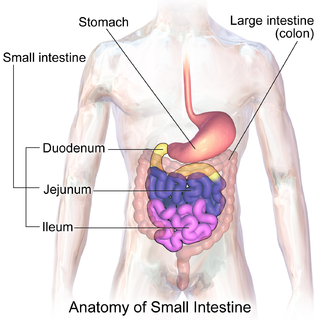This article needs additional citations for verification .(March 2014) |
An antiflatulent (or deflatulent) agent is a drug used for the alleviation or prevention of excessive intestinal gas, i.e., flatulence.
This article needs additional citations for verification .(March 2014) |
An antiflatulent (or deflatulent) agent is a drug used for the alleviation or prevention of excessive intestinal gas, i.e., flatulence.
For the alleviation of flatulence, an antifoaming agent such as simethicone may be taken orally. This agent will coalesce the smaller gas bubbles into larger bubbles, thereby easing the release of gas within the gastrointestinal tract via burping or flatulence.

Flatulence is defined in the medical literature as "flatus expelled through the anus" or the "quality or state of being flatulent", which is defined in turn as "marked by or affected with gases generated in the intestine or stomach; likely to cause digestive flatulence". The root of these words is from the Latin flatus – "a blowing, a breaking wind". Flatus is also the medical word for gas generated in the stomach or bowels. Despite these standard definitions, a proportion of intestinal gas may be swallowed environmental air, and hence flatus is not totally generated in the stomach or bowels. The scientific study of this area of medicine is termed flatology.

Lactose is a disaccharide. It is a sugar composed of galactose and glucose subunits and has the molecular formula C12H22O11. Lactose makes up around 2–8% of milk (by weight). The name comes from lac (gen. lactis), the Latin word for milk, plus the suffix -ose used to name sugars. The compound is a white, water-soluble, non-hygroscopic solid with a mildly sweet taste. It is used in the food industry.

Lactase is an enzyme produced by many organisms. It is located in the brush border of the small intestine of humans and other mammals. Lactase is essential to the complete digestion of whole milk; it breaks down lactose, a sugar which gives milk its sweetness. Lacking lactase, a person consuming dairy products may experience the symptoms of lactose intolerance. Lactase can be purchased as a food supplement, and is added to milk to produce "lactose-free" milk products.

Lactose intolerance is a common condition caused by a decreased ability to digest lactose, a sugar found in dairy products. Those affected vary in the amount of lactose they can tolerate before symptoms develop. Symptoms may include abdominal pain, bloating, diarrhea, gas, and nausea. These symptoms typically start thirty minutes to two hours after eating or drinking milk-based food. Their severity typically depends on the amount a person eats or drinks. Lactose intolerance does not cause damage to the gastrointestinal tract.

The small intestine or small bowel is an organ in the gastrointestinal tract where most of the absorption of nutrients from food takes place. It lies between the stomach and large intestine, and receives bile and pancreatic juice through the pancreatic duct to aid in digestion. The small intestine is about 18 feet long and folds many times to fit in the abdomen. Although it is longer than the large intestine, it is called the small intestine because it is narrower in width.

Digestion is the breakdown of large insoluble food molecules into small water-soluble food molecules so that they can be absorbed into the watery blood plasma. In certain organisms, these smaller substances are absorbed through the small intestine into the blood stream. Digestion is a form of catabolism that is often divided into two processes based on how food is broken down: mechanical and chemical digestion. The term mechanical digestion refers to the physical breakdown of large pieces of food into smaller pieces which can subsequently be accessed by digestive enzymes. Mechanical digestion takes place in mouth through mastication and in small intestine through segmentation contractions. In chemical digestion, enzymes break down food into the small molecules the body can use.

Garam masala is a blend of ground spices, originating from South Asia, common in Indian, Pakistani, Nepalese, and Bangladeshi, cuisines. It is used alone or with other seasonings.

Enterocytes, or intestinal absorptive cells, are simple columnar epithelial cells which line the inner surface of the small and large intestines. A glycocalyx surface coat contains digestive enzymes. Microvilli on the apical surface increase its surface area. This facilitates transport of numerous small molecules into the enterocyte from the intestinal lumen. These include broken down proteins, fats, and sugars, as well as water, electrolytes, vitamins, and bile salts. Enterocytes also have an endocrine role, secreting hormones such as leptin.
Digestive enzymes are a group of enzymes that break down polymeric macromolecules into their smaller building blocks, in order to facilitate their absorption by the body. Digestive enzymes are found in the digestive tracts of animals and in the tracts of carnivorous plants, where they aid in the digestion of food, as well as inside cells, especially in their lysosomes, where they function to maintain cellular survival. Digestive enzymes of diverse specificities are found in the saliva secreted by the salivary glands, in the secretions of cells lining the stomach, in the pancreatic juice secreted by pancreatic exocrine cells, and in the secretions of cells lining the small and large intestines.
Assimilation is the process of absorption of vitamins, minerals, and other chemicals from food within the gastrointestinal tract, as part of the nutrition of an organism. In humans, this is always done with a chemical breakdown and physical breakdown. The second process of bio assimilation is the chemical alteration of substances in the bloodstream by the liver or cellular secretions. Although a few similar compounds can be absorbed in digestion bio assimilation, the bioavailability of many compounds is dictated by this second process since both the liver and cellular secretions can be very specific in their metabolic action. This second process is where the absorbed food reaches the cells via the liver.
A carminative, also known as carminativum, is a herb or preparation intended to either prevent formation of gas in the gastrointestinal tract or facilitate the expulsion of said gas, thereby combatting flatulence.

Raffinose is a trisaccharide composed of galactose, glucose, and fructose. It can be found in beans, cabbage, brussels sprouts, broccoli, asparagus, other vegetables, and whole grains. Raffinose can be hydrolyzed to D-galactose and sucrose by the enzyme α-galactosidase (α-GAL), an enzyme not found in the human digestive tract. α-GAL also hydrolyzes other α-galactosides such as stachyose, verbascose, and galactinol, if present. The enzyme does not cleave β-linked galactose, as in lactose.

Beano is an enzyme-based dietary supplement that is used to reduce gas in the digestive tract, thereby improving digestion and reducing bloating, discomfort, and flatulence caused by gas. It contains the enzyme alpha-galactosidase (α-GAL). It was introduced as a liquid, but that has been discontinued and it is now available only as tablets and strawberry-flavored "Meltaways".
Abdominal bloating is a symptom that can appear at any age, generally associated with functional gastrointestinal disorders or organic diseases, but can also appear alone. The person feels gas in the stomach, or air filled in the stomach. Although this term is usually used interchangeably with abdominal distension, these symptoms probably have different pathophysiological processes, which are not fully understood.

Abdominal distension occurs when substances, such as air (gas) or fluid, accumulate in the abdomen causing its expansion. It is typically a symptom of an underlying disease or dysfunction in the body, rather than an illness in its own right. People suffering from this condition often describe it as "feeling bloated". Sufferers often experience a sensation of fullness, abdominal pressure, and sometimes nausea, pain, or cramping. In the most extreme cases, upward pressure on the diaphragm and lungs can also cause shortness of breath. Through a variety of causes, bloating is most commonly due to buildup of gas in the stomach, small intestine, or colon. The pressure sensation is often relieved, or at least lessened, by belching or flatulence. Medications that settle gas in the stomach and intestines are also commonly used to treat the discomfort and lessen the abdominal distension.

Galacto-oligosaccharides (GOS), also known as oligogalactosyllactose, oligogalactose, oligolactose or transgalactooligosaccharides (TOS), belong to the group of prebiotics. Prebiotics are defined as non-digestible food ingredients that beneficially affect the host by stimulating the growth and/or activity of beneficial bacteria in the colon. GOS occurs in commercially available products such as food for both infants and adults.
Human milk oligosaccharides, also known as human milk glycans, are short polymers of simple sugars that can be found in high concentrations exclusively in human breast milk.

Virginia H. Holsinger was a food scientist whose research was significant in the dairy industry. Her research on enzymes as dietary supplements and food treatments was critical to the development of Lactaid and Beano.
A low-FODMAP diet consists in the global restriction of all fermentable carbohydrates (FODMAPs), that is recommended only for a short time. A low-FODMAP diet is recommended for managing patients with irritable bowel syndrome (IBS) and can reduce digestive symptoms of IBS including bloating and flatulence.
Some herbs are also thought to counteract the flatulence effect, including cumin seed, epazote, asafoetida and winter savoury.